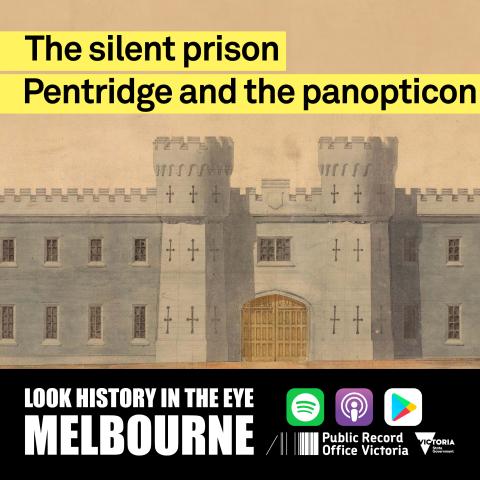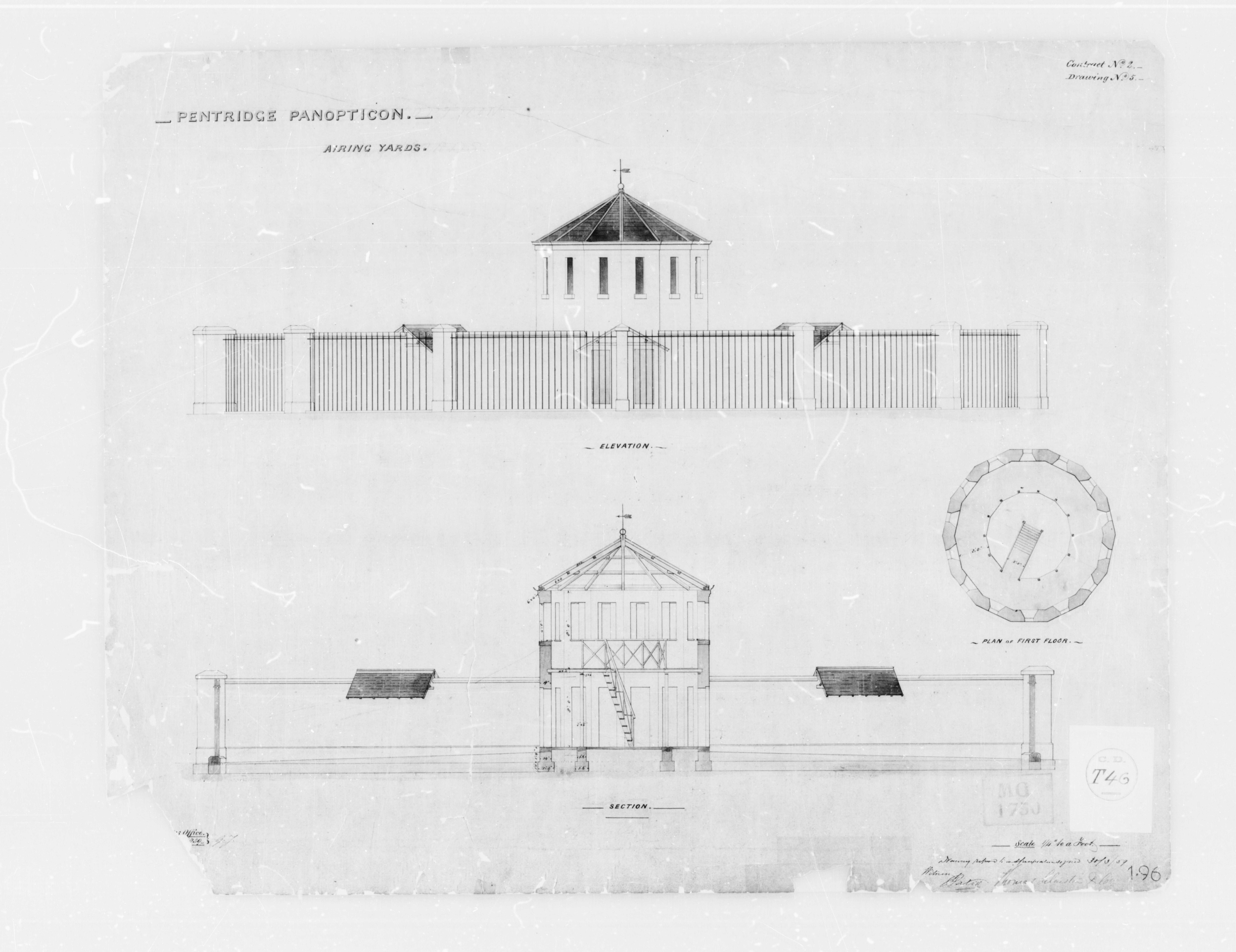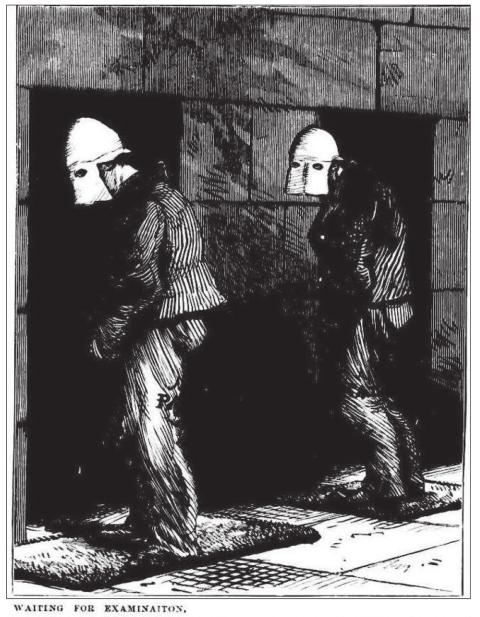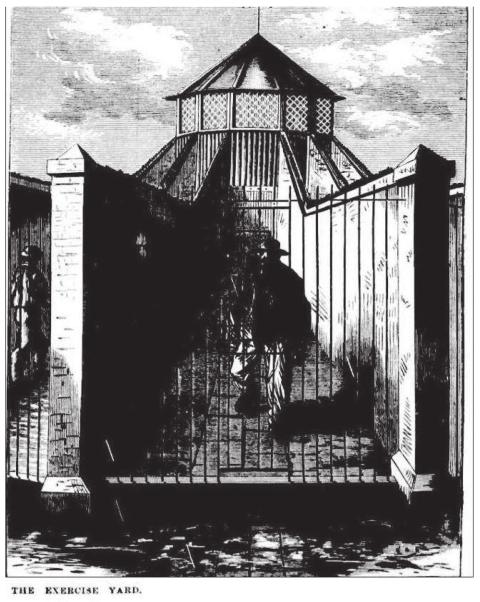Transcript Episode 1: The silent prison: Pentridge and the panopticon
Duration 22 min
From the podcast series 'Look history in the eye'
Written, produced and presented by Kate Follington and Public Record Office Victoria
Music and sound design by Jack Palmer
Guests: Adam Ford, Archaeologist; Geoff Hewitt, Archaeologist; Joseph Hillel and the Grubby Urchins
Adam Ford
It’s always a case of certain amount of relief, because you’ve talked to your client and you’ve got your team worked out and you have all these people digging and engaged, with the assumption that you’re going to find something significant, or you’re going to find these remains, and so when we got on site and worked with the big machine operators and we took the first couple of scrapes out and there was the outline of these walls it was just like yes! One, it’s relief, and two, it’s then excitement because I knew then that these structures were rare: not just in Victoria, but internationally they’re rare.
Kate Follington
That’s Adam Ford, a Melbourne based archaeologist and project director, talking about the discovery he made in 2014 of stone footings to an architectural structure known globally as a panopticon.
Hi, my name’s Kate Follington and you’re listening to the podcast Look History in the Eye produced by Public Record Office Victoria, we are the archive of the state government of Victoria. We hold one hundred kilometres of public records about Victoria’s past which are carefully preserved in climate controlled vaults. In this podcast we meet the people who dig into those boxes, look history in the eye, and bother to wonder why. You can download the record that began this story by searching Look History in the Eye podcast online.
This episode is about the convergence of ideology and design. The Panopticon’s and Pentridge prison itself were the physical manifestation of criminal reform in the 1800s. New radical concepts were designed into the architectural vision for the prison, it was paving the way for psychological experimentation and a method we now know has become one of mankind’s most brutal forms of punishment.
This prison is in the northern fringe of the city and was active until the mid ‘90s, and in 2004 it was sold, of course, to developers to build apartments and townhouses, but the deal was as long as certain sections were preserved as heritage the development could go ahead.
So, in 2014 Adam was brought in to work out what was worth keeping – and he knew that if he could find the panopticons they’d have local as well as global significance.
I did see some aerial photographs taken in the 1940s of the panopticon airing yards when they were still erect, and they looked bizarre, from an aerial view it was like looking down on a carnival troupe that had set themselves up inside the prison walls, they’d turned their giant wagon wheels on their side and laid them randomly across the prison complex.
Adam Ford
The Panopticons are if you imagine a large timber cart wheel laid on its side, and you’ve got the hub, the middle where the axel would have been, and spokes or radiating from the axil rim, and then you’ve got the perimeter, the wheel rim the tyre of the cartwheel, that’s kind of what they were but stone on the ground, they’re 30 metres across, the circle in the middle is the foundations of a two storey watchtower. And then radiating from the watchtower were these dividing walls which were overhead high, and prisoners left their solitary confinement for their one hour of exercise a day, they trouped into the base of the watch tower and then all faced a tiny little door which led out to their own tiny triangle exercise yard, and then they were told to walk and they had to walk for an hour. Yeah that was their Michelle Bridges 12 week transformation. It was all about this silent and separate system.
Kate Follington
Pentridge Prison was built in 1859, a few decades after Melbourne started as a British colony. It was designed to look like a gothic castle, it has curved medieval turrets stare down at you from the entry gate, and thick tall bluestone block walls – built by the prisoners themselves - stretch out for hundreds of metres in both directions. It’s kind of like something from the Game of Thrones.
Adam Ford
This formidable like structure, this fortress like structure silhouetted standing on the top of a hill silhouetted against the sky gave the community, that up until that point, had started to burst at the seams with the enormous numbers of people arriving for the gold rush, it gave them a feeling of confidence in the Government, and confidence in the justice system, and what they had seen as this burgeoning lawlessness was being treated seriously and was being controlled by the authorities.
Kate Follington
When news spread about the discovery of gold in Victoria thousands of ambitious emancipated convicts from the island of Tasmania and NSW headed to Victoria to seek their fortune, and there were some successful diggers, but the dreamers returned to Melbourne empty handed and hungry, and petty crime sky rocketed.
Melbourne had nowhere to put them so the worst of them were put onto floating hulks in Port Phillip locked in the gallows of abandoned ships sometimes for years.
Another solution used at the time was to whip criminals with the cat o’ nine tails. The cat of nine tails was a whip made of strips of knotted fabric, the whipping would lacerate the back skin of the victim, who was tied to a wooden frame, up to 50 times, usually delivered three times over several months, often in public, and then to ‘add salt to the wound’ which is where the phrase came from - they would splash salty water onto the cuts to reduce infection.
Ouch!
The best option if you committed a crime was to be sent to the road gangs at any of the stockyards around the City, so you could be road building from three to 12 months, but if you misbehaved you’d be shackled with metal weights this was called – hard labour in chains.
Adam Ford
Prior to the 19th Century punishment went two ways, it was either punitive, people were whipped or put in stocks, or beaten or hard labour, it was a way of physically meeting out the communities revenge on someone who’d been naughty, but if you were really bad, they just killed you. The designer thought there had to be a new way”
Kate Follington
An event that rocked the prison establishment occurred just as the Government decided it was time to try something new.
With the ships in the harbour full and Melbourne gaol overflowing…. the Inspector General of the Penal Settlement John Price, while visiting a prison road gang in Williamstown, was suddenly dragged down an alleyway at Gellibrand Point and bludgeoned to death with rocks by prisoners from the prison ship The Success, and they were complaining to him about their food rations and ill treatment by wardens, and they obviously didn’t like his reply because they then bludgeoned him to death.
It was pretty obvious to the Government of the day, they needed a new way to reform criminals - quickly and effectively.
Geoff Hewitt
The penitentiary was an entirely new concept, The British penal system they took over was based on the threat of of severe punishment, towards the end of the 18th Century there was something like 300 offences that were capital, if you cut down a cherry tree in an orchard that was an offence that was regarded as deserving capital punishment, there were various legal fictions that were available so the judges could avoid having to sentence people to death.
Kate Follington
That’s Geoff Hewitt a Melbourne archaeologist doing his PHD in philosophy, with a particular interest in the panopticon design because it ties very closely in with prison reform in the 1800s.
Geoff Hewitt
The main idea behind this reformability of people is an evangelical religious one, it was very much a part of the non-conformist approach to religion that had developed and transported to North America. It was all based on the notion that the human soul was capable of being converted and recovered and that people would respond and become good members of society if this could happen. The Quakers in north America, particularly Pennsylvania, thought that to connect to this divine spark within the person required them to be kept in isolation. Hence the idea of the separate system, the Pennsylvania prisons initially were single storey, and they all had a little window in the roof of their cell through which the light would come, and this was symbolic of the eye of god, and the eye of god shining upon the person who was stuck in this dark cell otherwise.
Kate Follington
And thus a new experiment on the spiritual reform of criminals began, and it was called the silent and separate system.
When designing Pentridge they decided to adopt a couple of different ideas.
On the one hand you had the forced religious self-reflection onto criminals - and on the other you had the influence of a utilitarian reformist who was on the rise in England, Jeremy Bentham.
He believed prisoners needed more than just spiritual enlightenment, they needed self-discipline and purpose. Prisons should be designed to offer prisoners a trade or a skill, as well as time to self reflect. So his prison design, presented to the English judicial system would achieve this goal, it wasn’t square, it wasn’t a floating hulk on the Thames, his prison design was tall and round and he called it, the Panopticon, a massive circular designed prison where all the prison cells are layered floor on floor around the outside walls, with the prisoner’s cells facing inward. In the centre, a tall guards tower rises from the floor – but you can’t see the guards, because they’re hidden behind slatted windows, so the prisoners were being watched - but they never knew if they were being watched.
Geoff Hewitt
It was a way of correcting deviant behaviour, by imposing self-control, and it’s intended to produce as a habit so that people will continue to behave appropriately whether they’re being observed or not. Bentham was also trying to make them profitable, and he felt they could be productive at some individual labour, whatever it might have been. Without necessarily having a supervisor looking over their shoulder. They could establish the habit of productive work with just the mere thought in their mind that they may be observed in the process.
Kate Follington
So if we return to 1857 Melbourne, the committee that had been pulled together to solve this prison crisis, or crime crisis, were keen to know more about this new idea about the silent system presented by William J Champ, he’d been in charge of convicts in Tasmania and so he was brought to Melbourne to replace the now bludgeoned John Price and to solve Melbourne’s prisoner problem.
Excerpt from the public record Select Committee Into Penal Discipline 1857 VPRS 3253 P0 Unit 26.
William J Champ voiced by Joseph Hillel and the Grubby Urchins.
And the very essence of the system I recommend, is the preservation of absolute silence. And the prevention of communication between the prisoners. The light would be from above, so no looking out at the windows, and the doors would be solid, of wood and very thick and closing so no sound could come through them, And each man would have his bell and ring if he was taken ill or wanting the warder, and the warder would be constantly walking up and down on carpet or matting with slippers on. And each door there would be an inspection aperture with plate glass. And as he walked along he would push it one side to observe the man inside, and the man inside could not hear the slightest sound.
Kate Follington
In the end Pentridge Prison was built to combine both the Quaker ideal of solitary confinement, and religious reflection, with radial corridors of stone cold cells stretching out in various directions from a single point - and then in addition built circular exercise yards with a guards tower in the middle, to match Bentham’s idea of blind observation. Hence the reason we had miniature panopticons in the middle of Pentridge.
Adam Ford
It was solitary confinement, they had their own cell, each cell had a flushing toilet and sink, which was revolutionary in the late 1850s. Crucially part of it was this idea that you never knew when you were being observed, they weren’t allowed to speak so when they did have their one hour of exercise, they were obliged to air them, that’s why they were called ‘airing yards’ they had to continue that silent system, and that secret observation I suppose, out into their airing yards, they’d go out for one hour a day, they’d walk into the base of the tower and into the yards, and walk up and down for an hour.
Now the design of the towers, two storey tower, up at the top there were two guards at the top of the tower who wandered around inside, but the windows were louvered, like slattered, so the prisoner if they casually looked up all they would see would be louvered windows and they would never know if they were being observed or not. Remember the prisoners whenever they left their cells they had to put a hood on, with just eye holes, a felt hat and a mask, so they couldn’t even engage in facial expressions with the other prisoners.
Kate Follington
I can’t help but wonder sometimes, if Bentham’s idea of the panopticon prison ideology of keeping ourselves in check for the good of society isn’t alive and well in any modern city. Thanks to CCTV we have a form of constant unidentifiable surveillance around us and perhaps CCTV cameras are imposing a form of self-control among us.
Geoff Hewitt
The concept was more to do with running manufacturing places rather than prisons, such as asylums and poor houses as well as prisons, where this idea of the centralised supervisor, who is silent and invisible could be making people productive. The collective happiness is more important than individual happiness, the total happiness of the mass is to have precedence over the will of the individual.
Adam Ford
A lot of people who entered the prison system, as now and then, had mental health issues, and to put them into solitary confinement was not good, people didn’t want to enter their own heads, because there be demons in there. So it was quickly established, that it wasn’t working, and it was much better to see prisoners, ok they weren’t allowed to speak, but in C division they were engaged in meaningful activities, and they’d been given work, perhaps for the first time ever they were given work and they finished something, and that was probably a much better contribution to re-entering society, than sitting in a room by yourself picking burs out of wool. There was an economic factor as well but you could see that the separate system was abandoned within about twenty five years and started putting two people in each cell. Therefore you can’t be classes as a separate system.
Kate Follington
The panopticon stone footings at the Pentridge Prison development, will be preserved, in among new townhouses, the noisy cafés and the planned cinemas – we might see a large circular glass surface to walk on in amongst it, and we’ll be able to look down, to see the original brick outline of the Panopticon triangular airing yards - and walk the small space prisoners were given during their one hour break from the hell of the solitary and silent system.
And if you do get a chance to look at the stone footing, think about it as a nod to architectural heritage, to Bentham’s reformist ideals and to the beginning of the penitentiary, a system still used today.
Solitary confinement in fact, is also still practiced in Victorian prisons. In 2019 Ombudsmann Deborah Glass called for a ban on solitary confinement of up to 22 hours a day, she produced a damning report into youth correctional facilities which found the practice widespread and misused by staff..…she said it leads to hallucinations, psychosis, self-harm and suicide.
The circular panopticon airing yards, and the separate silent system at Pentridge was implemented in 1859 – it was presented as a more humane way to reform the soul, but I can’t help but ask myself if we simply replaced one form of torture with another.
The Exercise Yard – A Prison Poem. No Author. The Bulletin 1899. Sourced from Trove.
Prisoner voiced by Joseph Hillel and the Grubby Urchins. 2020




